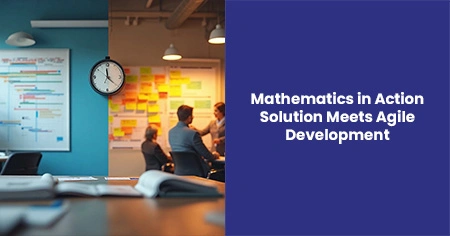While traditional waterfall projects continue to struggle, agile approaches have demonstrated remarkable improvements. According to research, agile projects deliver software 37% faster and achieve 16% higher productivity compared to plan-driven approaches. Furthermore, a comprehensive survey revealed success rates of 72% for agile projects versus only 63% for waterfall methodologies.
In this guide, we'll explore how mathematical modeling can help your team make better decisions under uncertainty. We'll demonstrate practical techniques for risk mitigation, value delivery modeling, and process selection that can significantly improve your project outcomes. By understanding the mathematical principles behind agile methodologies, we can better predict, manage, and ultimately succeed in an environment where change is constant.
Understanding Uncertainty in Agile Projects
Software development exists in a realm of perpetual uncertainty. The evidence is clear: uncertainty is not merely an occasional challenge but rather an inherent characteristic of software projects. Estimates in software development projects typically achieve only 25% to 75% accuracy, highlighting the fundamental unpredictability that teams face daily.
Common sources of unpredictability in software development
Software development is inherently unpredictable because it fundamentally involves discovery and invention. When writing software, developers are creating something new rather than reproducing existing solutions. This discovery of nature makes traditional estimation extraordinarily difficult.
Primary sources of unpredictability include:
- Requirement ambiguity - Ever-changing user environments make capturing precise requirements difficult, leading to faulty captures that become potential threats to project success
- Optimism bias - Developers tend to underestimate time requirements by approximately 50% due to natural optimism about their abilities
- Scope evolution - "Scope creep" occurs when the project scope morphs into something completely different than initially planned
- Technical complications - Poor quality code, bugs, and logical errors create unexpected delays
- External factors - Unpredictable elements like regulatory changes, economic shifts, and natural disasters
Indeed, software development isn't unpredictable because of unknown external influences but primarily because its very nature is discovery-based.
Impact of changing requirements on delivery timelines
Changing requirements represent one of the most significant challenges to project schedules. The mathematics in action solution recognizes that schedule expansion is a natural consequence of uncertainty. Each additional requirement or change creates a ripple effect throughout the project timeline.
Estimates differ from reality because uncertainties arise in multiple ways - from incomplete requirements to unforeseen implementation challenges. Most importantly, there's a mathematical reality at play: tasks are more likely to require more effort than planned rather than less. This statistical asymmetry means that even when as many tasks are under-estimated as over-estimated, the overall impact on schedules is predominantly negative.
Moreover, late-stage requirement changes can be particularly disruptive, often requiring rethinking overall solutions and potentially redevelopment at multiple layers. This explains why the cone of uncertainty concept shows that early estimates can vary dramatically from final results.
Why traditional planning fails under high uncertainty
Traditional planning approaches rely on a fundamental assumption: that past conditions will continue into the future. In high-uncertainty environments, this assumption breaks down completely. As conditions change rapidly, plans based on previous years become increasingly unreliable without significant adjustments.
Fixed planning cycles, typically annual reviews, cannot accommodate rapid changes or unexpected disruptions. Businesses simply cannot wait a year to revisit strategies when market conditions evolve weekly or monthly.
Additionally, traditional planning methods often aim to reduce uncertainty to acceptable levels before starting work. This approach limits innovation potential and can result in solutions that become obsolete shortly after release. Consequently, traditional methods tend to maximize predictability at the expense of value creation.
The mathematics in action solution acknowledges that agile approaches handle uncertainty by committing to what can truly be controlled—the schedule—and adjusting scope as required to meet that schedule. This strategy proves particularly effective in high-uncertainty environments where estimation accuracy is known to be limited.
Mathematical Modeling of Agile vs Plan-Driven Approaches
To truly grasp why agile methods outperform traditional approaches under uncertainty, we must examine their mathematical foundations. The mathematics in action solution offers us formal models that explain what practitioners have observed empirically for years - agile methodologies provide measurable advantages in uncertain environments.
Defining project scope and constraints mathematically
The foundation of project modeling lies in the Project Management Triangle, which mathematically expresses the relationship between three interdependent constraints: scope, time, and cost. In mathematical terms, this relationship can be represented as:
This STR model illustrates that scope (project complexity) is a function of time multiplied by resources. However, this relationship is not unbounded - adding more resources doesn't necessarily reduce time proportionally, a mathematical reality often overlooked in traditional planning.
Traditional plan-driven methodologies treat these constraints as fixed variables that can be predetermined with sufficient planning. In contrast, agile approaches recognize these as dynamic variables that must be continuously balanced. Mathematically, plan-driven models attempt to minimize the equation:
Project Risk = Σ(Uncertainty × Impact)
Where uncertainty is assumed to decrease with planning effort - an assumption that breaks down under high variability.
Modeling time and cost under uncertainty
The mathematics of uncertainty reveals why projects typically take longer than estimated. All estimates contain uncertainty, but this uncertainty is not symmetrically distributed. If a task is estimated at X days with an uncertainty factor of F, the possible range becomes [X/F, X×F].
For example, a 3-day task with an uncertainty factor of 2 has a best case of 1.5 days but a worst case of 6 days - demonstrating mathematical asymmetry. This asymmetry explains why, even with balanced estimation errors, projects tend to exceed their schedules.
A mathematical simulation of a 100-day project with an uncertainty factor of 2 for each task doesn't result in 100 days (naive estimate) or 200 days (worst case), but approximately 125 days - a 25% expansion. More realistic calculations using lognormal distributions show even more pessimistic results, with some projects mathematically predicted never to be completed
Crucially, the mathematics shows that reducing the size of estimation units improves accuracy. This directly supports the agile practice of breaking work into smaller increments.
Simulating delivery cycles using iteration-based models
Mathematical simulations comparing iteration-based (agile) and phase-based (plan-driven) approaches reveal striking differences in delivery patterns. In one comparative simulation, both projects faced identical uncertainties: work estimates being 25% too low and four 3-week unexpected delays. The results showed the plan-driven project's schedule expanded from 9 months to 14 months - a 56% increase. The agile project, though also delayed, delivered functional increments throughout the timeline.
The mathematics of iteration-based models demonstrates that shorter delivery cycles create a fundamentally different value equation:
Value(agile) = Σ(Feature_value × Time_in_use)
Whereas plan-driven approaches follow:
Value(plan-driven) = Σ(Feature_value) × (1 - Delay_penalty)
This mathematical difference explains why research found agile projects were 37% faster in delivering software and 16% more productive than plan-driven projects. The mathematics in action solution proves the agile advantage isn't philosophical but mathematical - breaking uncertainty into smaller units fundamentally changes the calculus of software development, creating measurable improvements in delivery timelines and value generation under identical conditions.
Applying the Mathematics in Action Solution
The practical application of mathematical models in agile environments creates measurable advantages for teams facing uncertainty. Let's explore how these principles translate into tangible business outcomes.
Incremental value delivery and ROI modeling
Mathematically speaking, an agile ROI model based on incremental delivery fundamentally changes the value equation. In traditional projects, value is only realized at the end of development, whereas agile approaches follow a different formula:
Value(agile) = Σ(Feature_value × Time_in_use)
This equation illustrates why early delivery matters: each feature begins generating value from the moment it reaches users. According to agile delivery metrics, teams deliver software 37% faster and achieve 16% higher productivity than plan-driven approaches. Key agile delivery metrics such as cycle time, throughput, and lead time help quantify the value generated in each sprint.
The mathematics in action solution recognizes that value doesn't accumulate linearly but compounds through feedback and adaptation. By maintaining well-prioritized product backlogs, teams ensure every sprint focuses on the highest-impact tasks, subsequently enhancing ROI. This prioritization prevents wasted resources on lower-value work.
In essence, the most effective value delivery model involves:
- Breaking large initiatives into small, independent features
- Deploying valuable increments early and often
- Measuring actual usage to inform future development priorities
Risk mitigation through early feedback loops
Feedback loops in agile represent a mathematical risk-reduction mechanism that enhances both learning and delivery. Each feedback cycle creates an opportunity to identify and address issues before they compound:
Risk = Σ(Problem_impact × Time_undiscovered)
Early feedback dramatically shortens the "Time_undiscovered" variable, thereby reducing overall project risk. As Henrik Kniberg and Mattias Skarin noted, "Generally speaking, you want as short a feedback loop as possible, so you can adapt your process quickly".
The mathematics in action solution leverages multiple feedback types:
- Sprint reviews that validate working software against stakeholder expectations
- Daily standups that identify obstacles within 24 hours
- User testing that confirms solution-market fit
- Retrospectives that improve team performance iteratively
Given that software development embodies the butterfly effect, where minor changes can result in significantly different outcomes, waiting until the end of a sprint is often too long for critical feedback. Continuous feedback prevents teams from investing resources in solutions no longer aligned with requirements.
Cost-benefit analysis of short vs long cycles
The cost-benefit ratio of short versus long cycles reveals a clear mathematical advantage. For shorter cycles:
B/C Ratio = (Early_value + Adaptation_value) / Development_cost
Shorter cycles not only deliver value earlier but also reduce the risk of building unwanted features. Mathematically, this creates an asymmetric advantage where potential gains outweigh potential losses. In practical application, benefit/cost analysis determines whether a project is efficient (B/C ratio > 1), inefficient (B/C ratio < 1), or at cost efficiency (B/C ratio = 1). For agile projects, the ability to terminate inefficient efforts early creates a portfolio-level advantage.
The mathematics in action solution demonstrates that schedule compression through shorter cycles doesn't just accelerate delivery—it fundamentally changes the economics of software development. One executive was advised that his organization would be "halfway there" if they simply never approved projects longer than three months. Primarily, this approach creates smaller bets with faster feedback, allowing teams to allocate resources where they generate maximum value.
Case Simulation: Agile vs Plan-Driven Under Identical Conditions
To put mathematical theory to the test, let's analyze a thought experiment (what Einstein called a "Gedanken Experiment") that compares agile and plan-driven approaches under identical conditions.
Setup of the simulation: team, scope, and environment
The simulation involves two identical projects tasked with creating a data warehouse and reporting system with five reports, deployed in a new data center. Both projects:
- Use identical team compositions and capabilities
- Share the same scope requirements
- Operate in the same business environment
- Have funding for exactly one year
- Must generate revenue by year-end to secure continued funding
This controlled simulation isolates one critical variable: the length of the development cycle. The plan-driven project follows a traditional waterfall approach with upfront planning, whereas the agile project uses shorter iterative cycles.
Schedule expansion due to uncertainty: a comparative view
Both projects face identical uncertainties:
- All work estimates are 25% too low
- Four specific technical issues arise (each causing 3-week delays):
- A large table (80 million records) requiring special processing
- Required software upgrade ten months into development
- Duplicate data in source tables
- Production deployment problems
The mathematics in action solution reveals striking differences in schedule impact. The plan-driven project's timeline expands from 9 months to 14 months—a 56% increase. During this entire period, no working software was delivered.
Meanwhile, the agile project's delivery timeline shifts as follows:
- Report 1: from 3 to 4.5 months
- Report 2: from 5 to 7.8 months
- Report 3: from 7 to 11.0 months
- Reports 4-5: beyond the funded year
Revenue generation timeline in agile vs plan-driven
The financial outcomes demonstrate why the mathematics in action solution favors shorter cycles. Primarily, the plan-driven project fails to deliver any value within the funded year, resulting in project cancelation and complete investment loss.
In fact, the agile project delivers three working reports within the funded year, generating revenue despite facing identical uncertainties. This revenue stream enables the project to qualify for continuation.
The simulation illustrates a fundamental principle: agile approaches don't eliminate uncertainty but transform how it impacts business outcomes. Through shorter cycles, teams can deliver partial value even when full scope completion is impossible under uncertainty. This ability to extract some return on investment, despite identical constraints, represents the core advantage of the mathematics in action solution.
Decision Framework for Agile Process Selection

Selecting the right agile methodology requires more than intuition—it demands a structured analysis of project variables. The mathematics in action solution offers a framework for matching methodologies to project characteristics based on mathematical principles.
Mapping project characteristics to process types
Every project exists on a spectrum of uncertainty and complexity. Primarily, the decision between different agile approaches hinges on two critical factors: work predictability and delivery requirements. Projects with continuous workflows benefit most from Kanban, whereas those requiring regular delivery cycles align better with Scrum.
Specifically, teams must evaluate:
- Work arrival pattern: Is work arriving continuously or in planned batches?
- Team structure: Do you need defined roles or prefer flexibility?
- Delivery expectations: Are regular time-based deliveries required?
The mathematics in action solution reveals that methodologies create different value equations based on these characteristics. Scrum optimizes for regular value delivery within time constraints, while Kanban maximizes flow efficiency.
Using estimation reliability and requirement stability
Requirement stability serves as a crucial mathematical variable in methodology selection. When requirements change frequently, estimation reliability decreases proportionally. Hence, less stable requirements call for processes with greater adaptability.
For high estimation reliability and stable requirements, Scrum provides structure through sprints. Alternatively, when estimation reliability is low and requirements fluctuate regularly, Kanban offers superior flexibility.
The relationship can be expressed as:
Process flexibility needed ∝ (Requirement volatility × Estimation uncertainty) Teams should carefully evaluate their estimation accuracy history. If estimates consistently vary by more than 50% from actuals, this indicates the need for frameworks with higher adaptability.
When to choose Scrum, CBPM, or Kanban
Ultimately, each methodology addresses specific project conditions:
Choose Scrum when:
- Requirements are relatively stable and can be planned in advance
- Teams benefit from a rigid structure and defined roles
- Regular delivery cycles are essential
Choose Kanban when:
- Work arrives continuously with unpredictable patterns
- Environment requires exceptional flexibility to adapt quickly
- Teams need to improve established processes incrementally
- Projects have varying priorities that change frequently
Consider hybrid approaches when:
- Teams need both structure and flexibility
- Different work types require different handling methods
- Continuous improvement is a priority alongside predictable delivery
Still, remember that mathematical modeling shows hybrid approaches create their own coordination costs. As such, the mathematics in action solution recommends starting with a pure methodology, then adapting only after mastering its fundamental principles.
Conclusion
Throughout this guide, we've explored how mathematical principles can revolutionize agile project management. The evidence clearly demonstrates that agile approaches deliver software 37% faster with 16% higher productivity compared to traditional methods. This advantage stems not from philosophical differences but from fundamental mathematical realities. First and foremost, uncertainty in software development creates asymmetrical risks. When a task estimated at 3 days has an uncertainty factor of 2, the best case becomes 1.5 days while the worst case extends to 6 days. This mathematical asymmetry explains why projects typically exceed schedules even with balanced estimation errors.
Additionally, the incremental value delivery model transforms the entire return on investment equation. While traditional projects realize value only upon completion, agile teams generate value continuously through each delivered increment. This creates a compounding effect where early feedback drives better decisions and reduces waste.
The case simulation proved especially revealing. Under identical conditions and constraints, the agile approach delivered three working reports generating actual revenue, whereas the plan-driven project failed completely. Consequently, teams must recognize that shorter cycles don't just accelerate delivery—they fundamentally change project economics.
Lastly, the decision framework provides practical guidance for methodology selection based on mathematical variables. Teams must evaluate work arrival patterns, requirement stability, and estimation reliability to choose between Scrum, Kanban, or hybrid approaches.
The mathematics in action solution offers agile teams a powerful framework to navigate uncertainty. Though uncertainty remains an inherent characteristic of software development, mathematical modeling equips teams to make better-informed decisions, prioritize effectively, and deliver measurable business value despite unpredictability. The difference between project success and failure often lies not in eliminating uncertainty but in managing it mathematically.
FAQs
Q1. How does agile methodology improve project outcomes compared to traditional approaches?
Agile methodologies have been shown to deliver software 37% faster and achieve 16% higher productivity compared to traditional plan-driven approaches. This is due to agile's focus on incremental value delivery, early feedback loops, and adaptability to changing requirements.
Q2. What is the mathematical basis for agile's effectiveness in handling uncertainty?
Agile's effectiveness stems from breaking work into smaller increments, which improves estimation accuracy. Mathematically, this reduces the impact of uncertainty by limiting the asymmetrical risk associated with longer estimation periods. Shorter cycles also allow for faster feedback and value generation.
Q3. How does agile change the return on investment (ROI) equation for software projects?
Agile transforms the ROI equation by enabling incremental value delivery. While traditional projects only realize value upon completion, agile teams generate value continuously through each delivered increment. This creates a compounding effect where early feedback drives better decisions and reduces waste.
Q4. What factors should teams consider when choosing between Scrum and Kanban?
Teams should evaluate work arrival patterns, requirement stability, and estimation reliability. Scrum is better suited for projects with stable requirements and regular delivery cycles, while Kanban is ideal for continuous workflows with varying priorities. The choice depends on the project's specific characteristics and team needs.
Q5. How can mathematical modeling help agile teams improve their decision-making?








